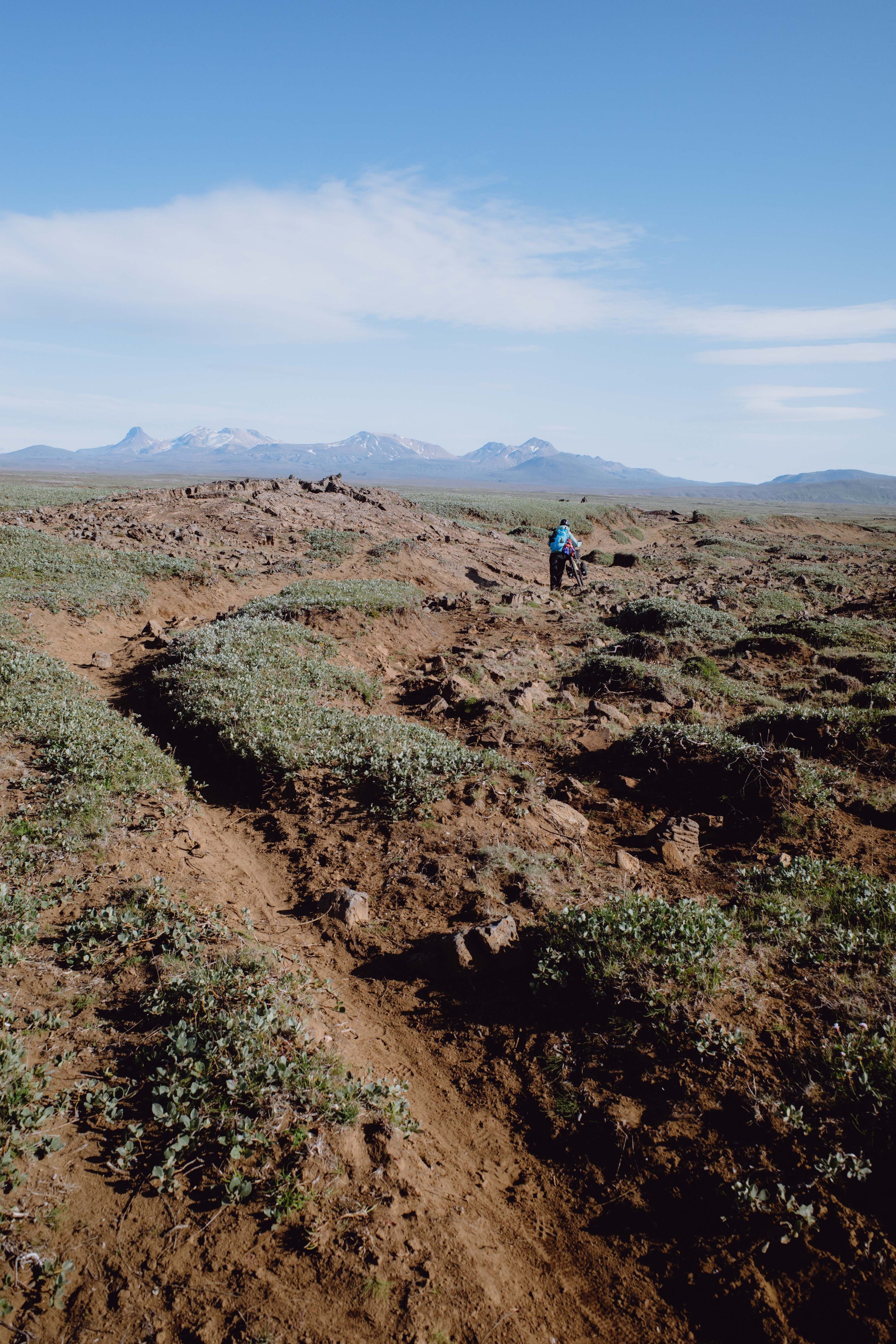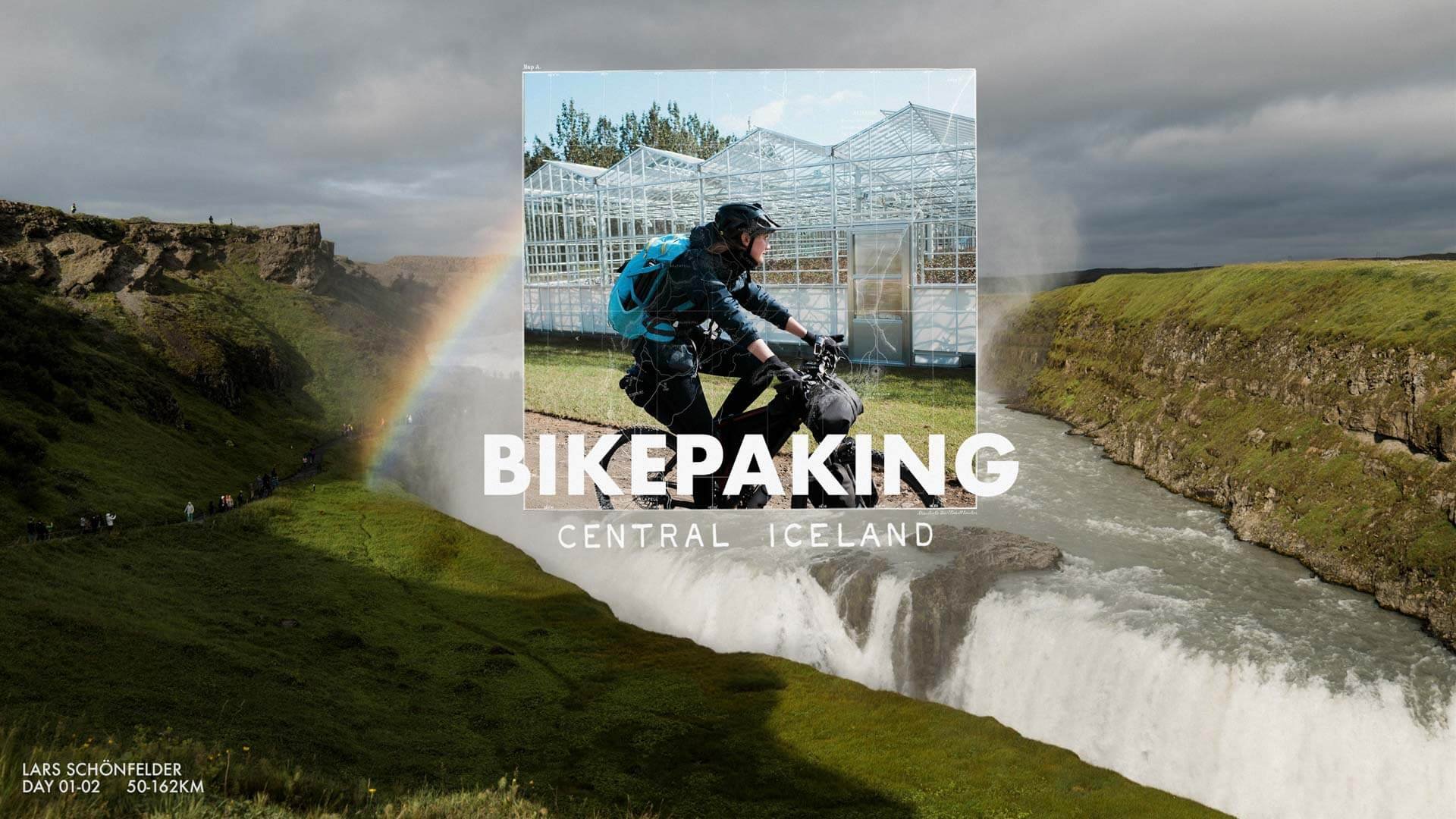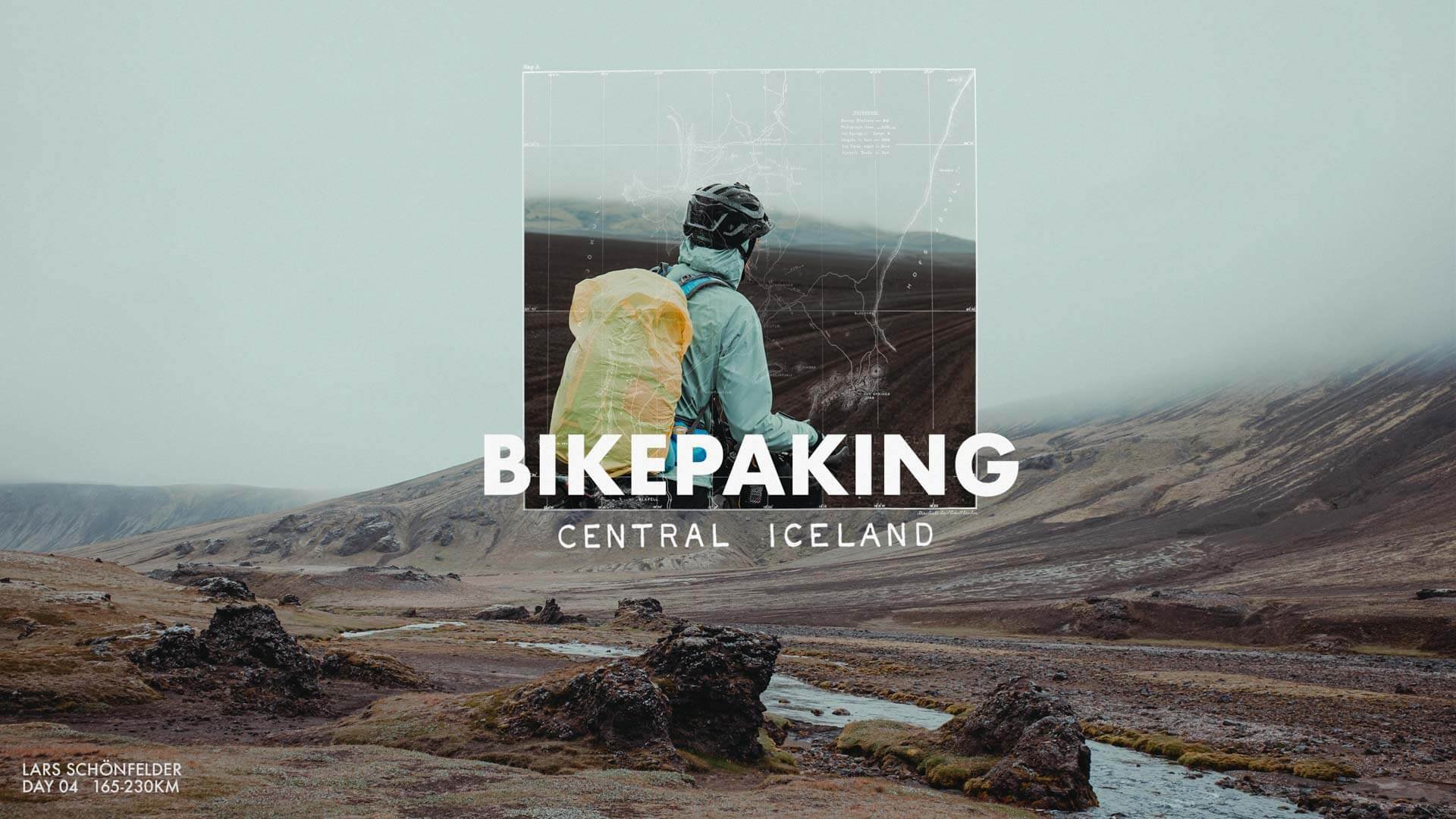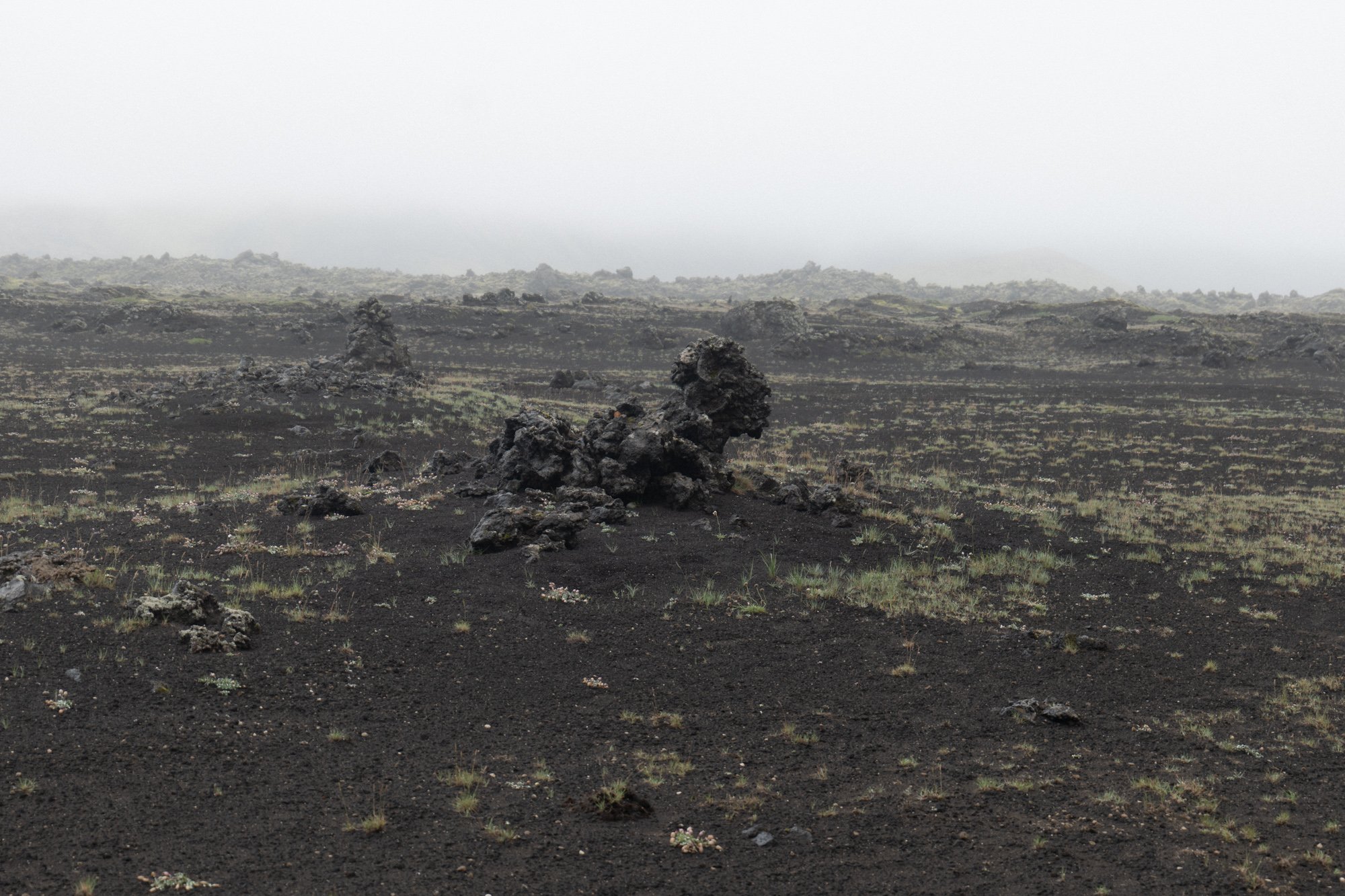

Route / Planning / Mountain Huts / Skogafoss / Glacier / Vestmanner / Trip Recap
Getting Started
We've wanted to travel for a longer period of time for some time now. However, it has often been difficult to find to find the necessary time for a longer trip like this.
After some additional issues with COVID, we decided to travel to Iceland as they had just reopened their borders. The country inspired us immediately, especially because of its diverse nature and the volcano "Fagradalsfjall," which erupted from March to September 2021.
We were fortunate to travel during this period despite ongoing travel restrictions for American and other foreign travelers. Therefore, even at tourist hotspots like Skogafoss or the Blue Lagoon, the crowds were manageable. After a lot of planning and a lot of consideration, we finally decided to travel around the country by bike.
Since we weren't really equipped (at all) for traveling by bike, we still had to learn a lot about it and buy some cycling gear and outdoor clothing.
Luckily, we already had bicycles, and we sewed most of the bags ourselves. Transporting a bike by plane requires either a bag or a large box, and there are specific regulations on how it should be packed. We read about the requirements on the airlines' website and wanted to pack our bikes in boxes, so we called a few bike shops to find the right size. The first shop we called had what we needed, and we were able to pick up the boxes. However, they were a bit too large, so we had to cut them down to size and use plenty of tape to secure them.
But even more than the equipment the route planning was really difficult, especially because we wanted to see as much as possible without being stressed by difficult or excessively long stretches.
After many hours of planning, we decided to start in the highlands. You can book a bus to take you there, and a one-way trip covers more different areas than a round trip.
Travel Preparation
Plan Your Own Adventure
-
To start off, there are quite a number of people who explore Iceland by bike, whether they are going around the island on the Ring Road or exploring the highlands.
If you're considering this type of trip, the first thing you need to know is how to get there with your bike.
Icelandair offers to transport packaged bicycles for €80 per flight. You can easily obtain a cardboard box for flying by calling your local bike shop in advance. We even managed to get boxes for free from the shop we called.
-
The challenge arises when you need to figure out where to store your cardboard box in Iceland. As far as we know, there are only two options:
1. Leave the bicycle packaged and take the bus to the Reykjavik campsite.The Fly Bus is an option, but you will need to take an additional bus from the central bus station (BSI) to the campsite, which can be a bit of a hassle. We recommend using public transportation instead, which should be cheaper. The storage cost at the campsite is pretty inexpensive, but you will need to pay for the bus, of course. This option may limit you somewhat because you will need to take the bus back as well. We paid a one-time fee of 3000 ISK or around €20 for the boxes. For long-term storage, we think this will be the best option since you are not paying for each individual day.
2. The other option is to build the bike in the bike box at the airport. This is a very convenient container-like place to assemble your bike with some tools available, and it's open 24/7.For the storage of the boxes, you could risk leaving them in the container. The safer option would be to put them in storage somehow. However, you have to remember to take the regional bus network if you would like to start your trip from a different location (Straeto). The airport shuttles usually do not like to take unpackaged bicycles, but the regional buses are very easy to use with the bike. Here are some storage options for the bike boxes:
1. The airport has its own luggage storage, which will cost you €5 per day for the first 10 days.
2. A couple we met stored their boxes at a car rental for €60 for two weeks.
3. We have read online somewhere that it is possible to store them at the youth hostel, but please check the process and availability for yourselves again.
-
We were pretty lucky at the beginning of our trip with three to four sunny and warm days, but we experienced the more typical Icelandic weather for the rest of the trip. When planning, make sure to have some options and alternatives ready to choose from in case of strong headwinds, bad weather, or a need for a quick exit back into civilization.
The Icelandic weather service has a phenomenal website to check wind speed and direction, temperature, cloud cover, and everything else weather-related. Be sure to check daily on your trip if you need to make alterations and to be prepared. We had planned to cycle along the southeast coast on the Ring Road counter-clockwise but had to adapt due to immensely strong headwinds for the entire rest of the week.
-
We decided to take a bus from Reykjavik directly into the highlands through a bus transfer to Hveravellir and start our trip from there. The bus took the F35 Kjölur route all the way to Akureyri in the north. We believe this was a really good option; however, it wasn't cheap.
You can choose to jump out wherever you like to start your trip and even get all the way to the north and start your trip from there.
This way, we saved some time getting into the highlands in the first place and were able to skip some of the F35 to reduce the amount of uncomfortable riding. We were glad we did this once we started on the trail.
-
You really have to think about the kind of trip you would like to have. On the one hand, with the right weather conditions, riding on smooth tarmac can be a lovely experience, but even during the COVID-19 pandemic in 2021, there were quite a few cars on the road, even far away from the Golden Circle.
In out opinion, to truly experience nature and not just visit tourist sites like you would do in a car, you need to get off the beaten path and onto the gravel roads. Otherwise, you might as well rent a car.
We think the beauty of biking is experiencing nature between the sights. Along the Ring Road, the cars can disturb the peace and quiet, at least in the south and east. I have heard that the Westfjords are quieter as well. -
Wild camping is somewhat allowed while traveling by bike in Iceland. However, we ended up sleeping on campsites most of the time as they are pretty cheap and also a good place to socialize after a lonely day of riding.
A typical campsite night costs around 1500-2200 ISK or around 10-15€ per person per night, making them a really good option. They are especially useful for getting water, showering, and even having hot running water in some cases. We were always grateful for a nice heated bathroom after a cold and windy day.
There is also a camping card which could reduce the cost of camping a bit. However, we would not recommend it because the campsites taking part are only a few and using it will introduce another constraint into planning your trip. We found it to be a better option to just roll into any campsite along the way without having to search and, most importantly, reach the next one while using the card. Someone gifted the card to us because she had to leave, so we ended up trying to use it. In the end, we only stayed on one campsite that accepted the card and they gave it to someone else.
The Cycling Iceland website has a lot of good information to check out, especially the cycling map, is absolutely phenomenal.
Just keep in mind that the dotted lines on the map represent really tough roads and will likely involve a hefty amount of bike pushing. We learned that lesson right away when we tried to take one at the very beginning, which turned out to be an unrideable horse riding track. But at least the views and weather were compensating for our effort.
When planning your trip, keep in mind that your bike will limit you to a certain extent. We would recommend a mountain bike with suspension, just to smooth out some of the washboard and rocks. Lars was on a hardtail gravel bike without any suspension, which was manageable but quite uncomfortable at times.
At least make sure to fit the widest tires possible for that case. We decided to avoid the major offroad sections after 2/3 of the trip because I was running out of spare tubes and the rear derailer was completely bent at one time in the middle of nowhere. So if you decide to go into the wilderness and I highly recommend taking enough spares and a really good multitool.

Skip the ring road! Bikepacking Iceland's Highlands and South #ep1
Witnessing the sunny side of the "Golden Circle" - Bikepacking Iceland #ep2
Swollowed by Iceland's wild Interior - Bikepacking Iceland #ep3
Trying to escape the Highlands - Bikepacking Iceland #ep4
Fighting the elements in Icelands wild south coast - Bikepacking Iceland #ep5

Lost in the Highlands
After setting off once again into the wild nature without any cellphone coverage, the weather started to turn, and we were cycling through an absolute lunar landscape with vast stretches of volcanic sand and rocks.
Mountain Huts
On a particular stretch of road, getting back into the highlands, we were exhausted and demotivated. After pushing through the bad weather with strong winds and rain, we found shelter in an old ruin where we could make some of our freeze-dried outdoor food. There, we decided to book a mountain cabin to lift our spirits and to have something to look forward to. Now with the goal in mind, we tried our best to stay positive and keep on going. After a while, the weather cleared up a fair bit, but the progress was still very slow.
After crossing a fairly big river to the last step, our mood was steadily improving with only a few kilometres to go.
Finally arriving at the finish line for the day, we were eager to get into the hopefully cozy hut. But we were, as it turned out, expecting way too from this tiny spot in the absolute middle of nowhere. After getting over the first shock of not being able to charge our stuff and not having hot water, we enjoyed having a solid place to sleep away from the elements for once.
On the map, you can find a selection of mountain huts scattered around the island. However, booking and getting access seems not to be super straightforward, so you need to check that in advance. I can’t remember exactly where I found the map, but hopefully, it will help you out.

Skogafoss
After a lot of struggle with the prevailing headwinds, we finally reached the Skogafoss, one of the most popular waterfalls and sights of Iceland. We were once again, like so many before, very lucky with the weather and had sunshine for the entire evening we spent at the waterfall.
If you have the time while visiting the site we would definitely advise you to take a quick walk up the stairs on the right-hand side for a stunning view of the landscape and the river leading up to the waterfall.

Camping at our “favourite” campsite near Skogafoss, we woke up to another stormy and cloudy day.
We had booked an ice climbing tour at the Sólheimajökull glacier and were very much looking forward to it. However, we first had to ride to the spot against a heavy headwind. Even with nearly all of our luggage removed and stored safely at the campsite, we were only moving forward at a snail's pace.
Finally, exhausted but glad that we were able to make it in time, we managed to reach the glacier even a few hours before the tour. We passed the time by walking around the glacier lagoon, taking pictures, and luckily flying the drone. Just before the tour was set to start, it began pouring down with rain and would not stop for the next three hours, pretty much for the entire tour.
However, somehow the rain didn't bother us at all, and we did not even take much notice of it. Probably it was due to the breathtaking scenery and stunning landscape all around us. The climbing part of the trip was pretty fun as well, even if we were seemingly thrust into the cliff without proper usage of an ice axe beforehand.
Glacier Tour
We struggled to decide where to go next after our time at the Sólheimajökull glacier and the ice climbing there. On the one hand, we wanted to have enough time at the end of our stay to try our luck with the volcano again. On the other hand, the weather did not look good at all in the upcoming days. Going further east would have been really tough because of the strong headwinds. So we decided to stay in the area for the time being and we ended up taking the ferry to the nearby Vestmannaeyjar Islands.
Under very low-hanging cloud cover, we embarked as the first ones onto the ferry. On land, we went straight to the next supermarket because you could not find any within a radius of 50km around Skogafoss.
After checking in and receiving a significant room upgrade, we were elated to have a proper hotel room for the first time on the trip, with a shower, fresh blankets, covers, and a small coffee machine. While Mari was enjoying the former luxuries, I was especially pleased by all the electrical outlets and the possibility of finally charging everything properly.
Luckily, we decided to use the rest of the day to explore the area, go to the far end, and explore the puffin colony living on the island.
VestmannaeyjarIslands










The first look out of our window the next morning revealed a thick layer of fog hanging about 50 meters above the ground, which persisted throughout the day. With rain coming in intervals of one or two hours, we decided to explore the stunning and well-designed museum of the volcanic eruption, as well as the beluga whale refuge centre in the bay. If you happen to be in the area, we would definitely recommend visiting both of these places.



















































